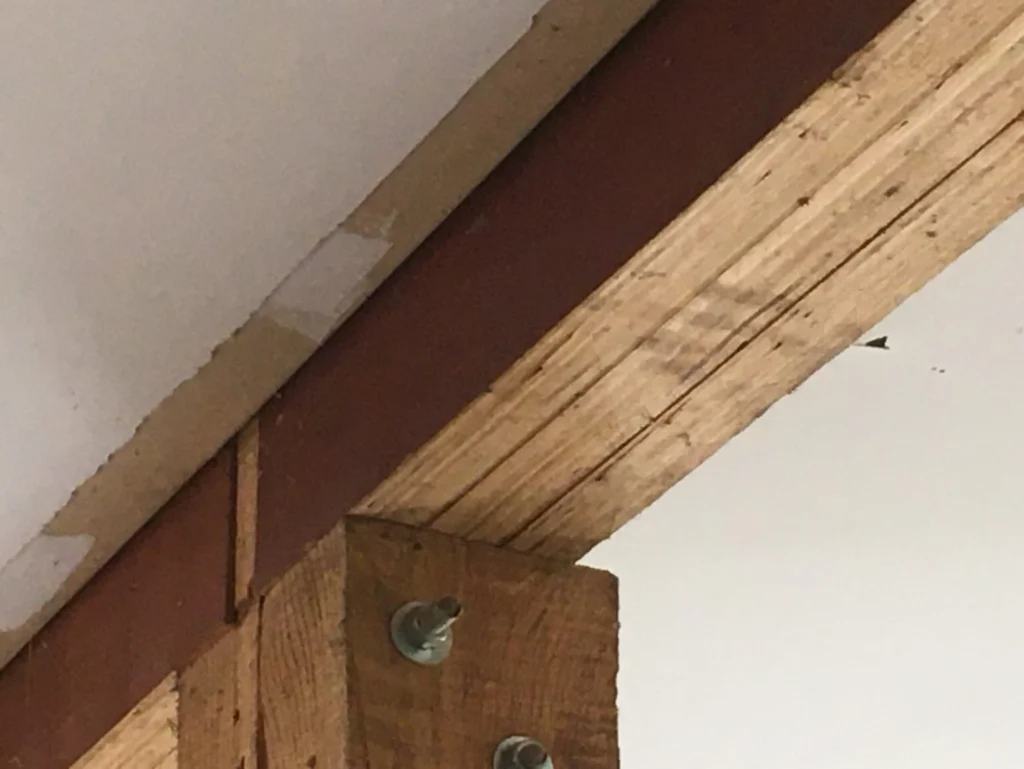Also see: Glulam Beam Weight & Volume Calculator.
Table of Contents

What Is LVL?
Laminated veneer lumber (LVL) is a type of structural composite lumber (SCL) engineered from thin layers of wood veneer bonded together with moisture-resistant adhesive. Unlike glulam, where pieces of lumber are glued edge-to-edge, LVL veneers are laid with all grain oriented in the same direction, producing a highly uniform and predictable product. LVL is one of the most widely used SCL products, and it is commonly specified for beams, headers, rim boards, and columns.
The adhesive used in LVL manufacturing is typically a waterproof phenolic resin, which ensures strength and stability even under fluctuating humidity. LVL products are manufactured in accordance with ASTM D5456, and may be audited/evaluated by the APA (the Engineered Wood Association), ICC-ES, or CCMC to ensure that standards are met so that LVL beams can deliver consistent performance and dimensional stability in residential, commercial, and industrial construction.
One of LVL’s major advantages compared to sawn lumber is its ability to provide long lengths (commonly up to 60 feet, and up to 80 feet in some cases) without the defects or variability found in solid wood. LVL members are factory-produced to be free from knots, splits, and slope-of-grain issues, making them stronger and more reliable than conventional lumber of similar size.
Wood Types, Dimensions, and Standard Weight of LVL
LVL in North America is typically manufactured from Douglas-fir, Southern Pine, or mixed softwood veneers, though some products incorporate hardwoods depending on the mill. Veneers are ultrasonically graded before lamination, which maximizes fiber strength and ensures excellent nail- and fastener-holding capacity.
Standard LVL beam thicknesses include 1½″, 1¾″, and 3½″, with some manufacturers also producing 5¼″ and 7″ sections for heavy-duty applications. Beam depths generally range from 9¼″ to 24″ in 1¾″ increments, coordinated with standard framing layouts so LVL integrates smoothly into joist and rafter systems.
Published manufacturer data shows that LVL has a practical density of about 41 lb/ft³ or sometimes slightly heavier. So, for instance, a 1¾″ × 9½″ piece of LVL should weigh about 4.7–4.8 pounds per lineal foot, and a 1¾″ × 11⅞″ LVL should weigh about 6 lb/ft.
Because LVL is straight, stable, and available in long lengths, it has largely replaced solid-sawn lumber for structural applications in new home construction such as headers, garage door beams, ridge beams, and floor or roof supports where uniform performance is required. Deeper LVL beams (16″ and above) are generally supplied as multi-ply assemblies for both structural capacity and handling reasons.
Beam Dimensions
The terms “thickness” and “depth” may be slightly confusing. Here’s a diagram so you know what thickness and depth refer to.
Example: LVL beam 1¾″ thickness × 9½″ depth.
LVL Beam Weight & Volume Calculator
This calculator assumes a density for glued laminated timber of 41 pounds per cubic foot (pcf). There are LVL products that vary from this weight value, so you should always check the manufacturer’s technical data sheet for the exact product you intend to use. You can change the density used by the calculator with the “LVL density” input.
This calculator takes decimal or fractional inputs for beam width and depth. When entering a thickness or depth greater than 1 that contains a fraction, such as 3 1/2, make sure to include a space between the whole number and the fraction. Type in “3 1/2”, not “31/8”.
About the LVL Weight Table
The following table provides the approximate weight (dead load, self-weight) for laminated veneer lumber (LVL) beams commonly used in building construction in North America. The table provides the weight per cubic foot as well as the weight per linear foot for various dimensions of LVL members. The values given in the table are meant to provide a general idea of typical weights for LVL beams, and should not be used if precise values are needed for critical engineering calculations.
When accuracy is critical, always consult the specification sheet for the exact LVL product you plan to use, or contact the manufacturer’s technical support department for verified weight and design data.
I also provide weights for dimensions (1 inch and 1/4 inch) that are not the actual dimensions of any real LVL beam. I did this to make it easier to use the table to calculate weights for custom beam dimensions that don’t have published standard weights and are not listed in the tables.
Table: Laminated Veneer Lumber (LVL) Weights
LVL typically weighs around 41 pounds per cubic foot, or about 3.4 pounds per board foot. (The trick is to figure out how many cubic feet are in the beam.)
| Weight of LVL (Laminated Veneer Lumber) | |||||||||||
|---|---|---|---|---|---|---|---|---|---|---|---|
| 41 Pounds per Cubic Foot (41 lbs/ft³) | |||||||||||
| 3.42 Pounds per Board Foot | |||||||||||
| Table shows approximate weight per linear foot for standard LVL beam thicknesses and a sample of LVL beam depths. |
|||||||||||
| LVL is not manufactured in thicknesses or depths of just 1 inch or just 1/4 inch; these are included for convenience when estimating weights of custom or non-standard sizes. |
|||||||||||
| Thickness in Inches | Depth (Height) in Inches | ||||||||||
| ↓ | ¼″ | 1″ | 7¼″ | 9¼″ | 9½″ | 11¼″ | 11⅞″ | 14″ | 16″ | 18″ | 24″ |
| 1″ | 0.07 lb | 0.29 | 2.06 | 2.63 | 2.71 | 3.20 | 3.38 | 3.99 | 4.56 | 5.13 | 6.83 |
| 1¾″ | 0.13 lb | 0.50 | 3.61 | 4.61 | 4.73 | 5.61 | 5.92 | 6.98 | 7.97 | 8.97 | 11.96 |
| 3½″ | 0.25 lb | 1.00 | 7.23 | 9.22 | 9.47 | 11.21 | 11.83 | 13.95 | 15.94 | 17.94 | 23.92 |
| 5¼″ | 0.38 lb | 1.50 | 10.85 | 13.82 | 14.20 | 16.81 | 17.75 | 20.93 | 23.91 | 26.91 | 35.88 |
| 7″ | 0.50 lb | 2.00 | 14.46 | 18.42 | 18.93 | 22.42 | 23.66 | 27.90 | 31.88 | 35.88 | 47.84 |
Further Information about LVL
To learn more about laminated veneer lumber (LVL), visit the websites of the APA (Engineered Wood Association) and major LVL manufacturers such as West Fraser and RedBuilt. These sources provide detailed information about structural composite lumber applications, beam sizing, design tables, product guides, and installation best practices. You may need to create a free account with the APA in order to access the publications (in PDF) that contain the most detailed technical information.
In particular, for technical data covering the physical properties of LVL beams, including weight per foot, design values, and allowable loads, see the manufacturer-specific LVL design guides (for example, West Fraser’s LVL User’s Guide or RedBuilt’s RedLam LVL Specifier’s Guide). These documents include beam span tables, section properties, and design stresses.

